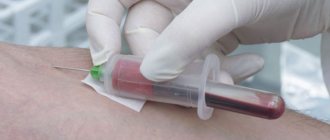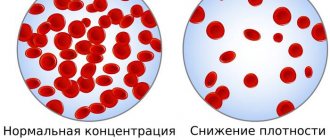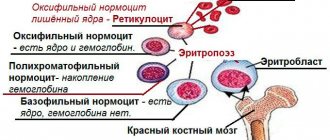There's so much you can't find on the net. Even the question about the color of blood and veins is often accompanied by assumptions and fiction, although most people actually know the answer. Yes, everything is simple here - the blood is red, only in different shades, depending on the amount of hemoglobin in it and oxygen enrichment. Everything is as taught in biology and BJD at school: arterial blood (rich in oxygen, coming from the heart) is bright scarlet , and venous blood (which has given oxygen to the organs, returning to the heart) is dark red (burgundy). The veins that are visible under the skin are also red when blood flows through them inside. After all, the blood vessels themselves are quite transparent. But still, many people have questions such as “Why does blood come in different colors and what does this depend on?” and “Why are veins blue or cyan?”
Color of discharge during menstruation: what to look for
The content of the article
The color of menstrual flow, when critical days arrive in a timely manner, can be different - from scarlet to black. Many factors influence the color change, as well as the thickness of the blood:
- medications taken during menstruation;
- diseases arising in this cycle;
- physical activity during the period;
- volume of discharge - the more blood, the brighter it will be and the fewer clots there will be;
- amount of fluid - the more it is, the lighter and thinner the blood.
Taking medication
Physical activity
Changes in the color and density of menstrual blood do not necessarily indicate a disorder, and it is difficult to make a diagnosis based on this symptom alone. Gynecologists agree that changes in the duration of menstruation, their irregularity or intensity are more important than the color of the blood during the period.
However, scientists from the American College of Obstetricians and Gynecologists published a report recommending that changes in menstrual blood be assessed as a significant symptom of disease. At the same time, they recommend measuring blood pressure and body temperature.
According to experts, the color of menstrual blood indicates the hormonal background, which affects the functioning of the entire body.
Incomplete separation of arterial and venous blood
Incomplete separation of arterial and venous blood occurs with heart defects and large vessels , as well as lung diseases:
- atrial septal defect;
- a hole in the septum between the ventricles;
- collapse of the walls (closing) of the alveoli of the lungs (atelectasis), filling with fluid (edema, pneumonia);
- fistula between a vein and an artery (congenital, less commonly acquired);
- transposition of the great vessels (aorta and pulmonary artery change places);
- underdevelopment of the heart chambers (two- and three-chamber);
- open arterial (ductus Botallus, connects the aorta and pulmonary artery).
Dark blood from a vein: what does it mean?
The dark color of blood from a vein means that the organ from which it flows is actively functioning. The higher the rate of metabolic processes, the more oxygen is absorbed from the blood, which means its color will be darker.
We recommend reading the article about venous congestion in the legs. From it you will learn about the causes and symptoms of the pathology, conservative and surgical treatment.
And here is more information about vascular injury.
- Why do the veins in the arms hurt in the elbow bend?
Venous blood flows from the organs, collects in the large vena cava and then into the right half of the heart. Through the pulmonary arteries it approaches the alveoli and turns into the arterial artery. The properties of blood from a vein are darker, thicker, and clot quickly. It is used for laboratory diagnostics, as it contains metabolic products, toxins, microbes, and hormones. Venous bleeding is accompanied by a slow and uniform release of blood; it is easier to stop than arterial bleeding.
Pink blood during menstruation
Pink blood during your period can mean low estrogen levels. Estrogens are the main female hormones and are produced by the ovaries. Their concentration increases in the first phase of the cycle.
When there is not enough estrogen, problems with menstruation arise - cycles become irregular. A lack of these hormones can also create problems with pregnancy.
Low estrogen levels can be caused by intense physical stress. Research has shown that vigorous exercise can lower these hormones, which can sometimes lead to menstrual irregularities, including missed periods.
Royal disease or blue blood sign
Hemophilia is a hereditary blood disorder that is caused by a congenital absence or decrease in the amount of blood clotting factors (most often VIII or IX). The disease is characterized by a blood clotting disorder and manifests itself in frequent hemorrhages in joints, muscles or internal organs.
The disease manifests itself only in males; women are carriers of the hemophilia gene. Hemophilia in a woman occurs very rarely and only if both parents were carriers of the mutation - such cases are 1 per 100 million people. In 70% of cases, the disease is inherited, in 30% it occurs in the event of a “breakdown” of a gene, i.e. no family can be immune from the fact that a sick child may be born into it.
Previously, hemophilia was considered a “royal” disease or a sign of blue blood. Its most famous carrier was Queen Victoria, who passed the dangerous gene on to her children, and after them to her grandchildren and great-grandchildren, including Tsarevich Alexei, the only son of Nicholas II. Since in those days consanguineous marriages were considered the norm and relatives formed families to preserve titles, lands and the throne, the disease became established and was very common in various royal dynasties.
Today, about 400 thousand people in the world suffer from hemophilia. There are more than 600 such patients in Belarus. They are included in the register of blood diseases and receive therapy free of charge.
The first signs of hemophilia can be detected immediately after birth: increased bleeding in the area of the navel stump, severe hematomas on the head and body. However, it is rarely possible to detect hemophilia in infancy, since the child receives a sufficient amount of active thrombokinase through mother's milk. At a later age, parents discover incessant weak bleeding when teething, the teeth injure the oral cavity and these wounds do not heal well. The most obvious signs appear from the moment when children begin to walk independently - due to minor bruises and falls, severe subcutaneous, joint and muscle bleeding occurs. With chronic hemarthrosis (accumulation of blood in the joints), joint mobility is lost and the need for joint replacement surgery arises.
Therefore, it is extremely important to take replacement therapy from the first days of diagnosis. Treatment can prevent bleeding or reduce its effects, reducing disability. Replacement therapy is the introduction of a deficient blood clotting factor into the patient's body directly into a vein to ensure a normal level of hemostasis.
The life prognosis for current hemophiliacs is favorable, subject to constant adherence to treatment conditions. Their average life expectancy is the same as that of healthy people.
The most important preventive measure is medical and genetic counseling for those entering into marriage. Identification of female carriers of the gene is possible by determining blood clotting factors VIII or IX in their blood using a quantitative biochemical method.
General practitioner of the Healthcare Institution “Korelichskaya Central District Hospital”
Natalia Manylo
Bright red menstrual blood
If the blood during this period is bright red, similar in color to cranberries, this is a sign that everything is in order. It is very good if menstruation is also regular.
Of course, monthly bleeding looks and feels different for every woman, but in general: a bright red period is a signal that there is no reason to worry.
ONLINE REGISTRATION at the DIANA clinic
You can sign up by calling the toll-free phone number 8-800-707-15-60 or filling out the contact form. In this case, we will contact you ourselves.
Bleeding
When providing first aid, it is important to know which blood is arterial and which is venous.
These species are easily identified by their flow patterns and color. With arterial bleeding, a fountain of bright scarlet blood is observed. The liquid flows out pulsatingly and quickly. This type of bleeding is difficult to stop, which is the danger of such injuries.
When providing first aid, it is necessary to raise the limb and compress the damaged vessel by applying a hemostatic tourniquet or pressing it with finger pressure. In case of arterial bleeding, the patient must be taken to the hospital as quickly as possible.
Arterial bleeding may be internal. In such cases, a large amount of blood enters the abdominal cavity or various organs. With this type of pathology, a person suddenly becomes ill, the skin turns pale. After some time, dizziness and loss of consciousness begin. This is due to lack of oxygen. Only doctors can provide assistance with this type of pathology.
With venous bleeding, dark cherry-colored blood flows out of the wound. It flows slowly, without pulsation. You can stop this bleeding yourself by applying a pressure bandage.
What changes should you be wary of?
The first thing you should pay attention to is the color change from cycle to cycle. The shade of the discharge should not change. For example, if a woman has always had red periods, and then they become very dark, almost black, this is a reason to be examined by a gynecologist.
Alarming symptoms when color changes are:
- intense pain in the lower abdomen;
- pain when emptying the bladder;
- frequent urination;
- violation of cycle duration;
- burning and itching;
- unpleasant (putrid) odor;
- pain radiating to the anus;
- fever, chills, weakness, dizziness.
The above symptoms may indicate the presence of an inflammatory process. Also, the reason for consulting a doctor is the appearance of discharge between periods, regardless of its shade.
Strange menstruation - no periods
Pregnancy is the main cause of amenorrhea among women under 50 years of age. However, amenorrhea without any reason is quite common, but missing your period for several months in a row is a warning sign. Besides pregnancy, other reasons for missing periods include stress, weight loss, over-exercising (long-distance running, etc.), hormonal problems and menopause.
You need to contact a gynecologist if you have not had your period for 2 months in a row. Additionally, you should make an appointment with your doctor if your first menstrual period does not start by age 16.
Menopause is the last menstruation for every woman. The cessation of menstruation occurs because over time the ovaries stop producing eggs and the amount of estrogen decreases. Menopause usually occurs around age 52. Premature menopause occurs before a woman turns 45, but it is rare.
There are other symptoms that indicate the passage of menopause, the most common being hot flashes. In case of bleeding after menopause, you should visit a gynecologist, then it is associated with suspected uterine cancer.
Why are veins blue and not red?
In fact, of course, although the veins carry dark burgundy blood, unlike the bright scarlet arterial blood, they are not at all blue in color. They are red, like the color of the blood that flows through them. And you shouldn’t believe in the theory that you can find on the Internet that the blood actually runs through the vessels is blue, but when cut and in contact with air it instantly turns red - this is not so. Blood is always red, and why is described above in the article.
The veins only appear blue to us. This is explained by the laws of physics about the reflection of light and our perception. When a beam of light hits the body, the skin reflects some of all the waves and therefore looks light, well, or different, depending on melanin. But it transmits the blue spectrum worse than red. But the vein itself, or rather the blood, absorbs light of all wavelengths (but less, in the red part of the spectrum). That is, it turns out that the skin gives us a blue color for visibility, and the vein itself gives us red. But, interestingly, the vein actually reflects even a little more red than the skin in the blue spectrum of light. But why then do we see veins blue or cyan? And the reason, in fact, lies in our perception - the brain compares the color of the blood vessel against the bright and warm tone of the skin, and in the end shows us blue.
Why don't we see other vessels through which blood flows?
If a blood vessel is located closer than 0.5 mm to the surface of the skin, then it generally absorbs almost all blue light, and reflects much more red light - the skin looks healthy pink (ruddy). If the vessel is much deeper than 0.5 mm, then it is simply not visible, because the light does not reach it. Therefore, it turns out that we see veins that are approximately located at a distance of 0.5 mm from the surface of the skin, and why they are blue has already been described above.
Why can't we see arteries from under the skin?
In fact, about two-thirds of the blood volume is permanently in the veins, which means they are larger than other vessels. In addition, arteries have much thicker walls than veins, because they have to withstand greater pressure, which also prevents them from being sufficiently transparent. But even if the arteries were visible from under the skin as well as some veins, it is assumed that they would have approximately the same color, despite the fact that the blood running through them is brighter.
What color are veins actually?
If you've ever cooked meat, you probably already know the answer to this question. Empty blood vessels are reddish-brown in color. There is not much difference in color between arteries and veins. They differ mainly when viewed in cross section. Arteries are thick-walled and muscular, while veins have thin walls.
Also learn about the main vein diseases worth knowing, as well as about varicose veins and their treatment.
Blood functions
Hardly anyone doubts that blood is necessary for the body, but perhaps not everyone can answer why it is needed. This liquid tissue performs several functions, including:
- Protective. The main role in protecting the body from infections and damage is played by leukocytes, namely neutrophils and monocytes. They rush and accumulate at the site of damage. Their main purpose is phagocytosis, that is, the absorption of microorganisms. Neutrophils are classified as microphages, and monocytes are classified as macrophages. Other types of white blood cells - lymphocytes - produce antibodies against harmful agents. In addition, leukocytes are involved in removing damaged and dead tissue from the body.
- Transport. Blood supply influences almost all processes occurring in the body, including the most important ones - breathing and digestion. With the help of blood, oxygen is transported from the lungs to the tissues and carbon dioxide from the tissues to the lungs, organic substances from the intestines to the cells, end products, which are then excreted by the kidneys, and the transport of hormones and other bioactive substances.
- Temperature regulation. A person needs blood to maintain a constant body temperature, the norm of which is in a very narrow range - about 37°C.
Strange scanty and heavy menstruation - is it dangerous?
The regularity and abundance of bleeding is an important factor in women's health. It is difficult to accurately determine blood loss during one menstrual cycle. Menstruation is considered heavy if a woman has to use double protection, blood gets on her bed linen, clots appear in the blood, or if her usual lifestyle has to be changed due to her period.
If your periods change and become more abundant than before, you definitely need to see a gynecologist. There are many reasons for heavy menstrual periods. However, in most women, the uterus is functioning properly and hormone levels are normal. Appropriate treatment can reduce heavy menstrual bleeding.










